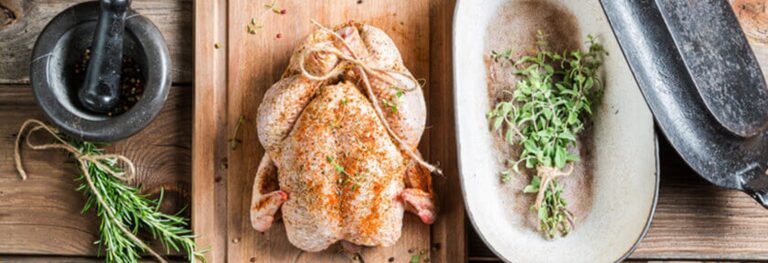
This can be tricky. Too much bird and you’re left with weeks of leftovers. Too little and you may not satisfy your crowd. You must ask yourself two questions:
Do you want left overs? If not, plan on around ¾ lb. per person. If so (who doesn’t love turkey sandwiches?), then plan on 1 lbs. per person.
How many adults and children?
Use our simple Turkey Cooking Times chart for a quick answer for what size bird you need based on both of these questions, along with thawing and cook times for the specified size turkey.
You’ve seen the USDA seal on nearly every turkey, almost always accompanied by the USDA Grade A shield. Nearly all turkeys in the U.S. are inspected by the USDA for wholesomeness and bear these seals. This means the turkey is free from pinfeathers, broken bones, and from large bruises, cuts, and skin tears. If the Grade A shield is not on the label, the turkey is safe and wholesome, but may have less than optimum appearance. If you’re planning to show off your beautiful turkey, you’ll want Grade A for that picture-perfect table.
Contrary to old wives’ tales, the only difference between a hen and a tom is the size of the bird. Hens are under 16 lbs. and toms are over 16 lbs. Both are tender, moist, and delicious.
This decision is purely based on preference. There are no hard and fast guides. However, there are some differences to note.
Pre-basted turkeys are juicer and extra tender, making them often preferred over their natural siblings. They will usually have a statement like “Solution of 10% seasonings and turkey broth injected.” Another benefit of pre-basted turkeys is they do not require the basting every hour like your mother or grandmother would have to do. Repeatedly opening the oven door only serves to heat up your kitchen and prolong the cooking time. Not to mention it pulls you away from the festivities of the day.
If you prefer a “natural” product without additives, an all-natural bird is what you’ll want to look for. This is also a good option if you prefer to make your own basting solution. Keep in mind the “natural” turkey tends to be drier as the basting is only skin-deep.
While most would never be able to tell the difference, there are some key variances in the prep work related to either a frozen or refrigerated turkey. Namely, the time.
Frozen turkeys must be thawed before they can be baked, usually over a few days. Meaning you must not only have room in your freezer to store it, but you must allow proper time before you plan to cook it. The pro to a frozen turkey is that you may purchase it in advance versus a refrigerated one, even a year in advance! This allows you to purchase it when it’s on sale or when it’s convenient for you.
Refrigerated turkeys are best if you plan to use your turkey right away or in a day or two. Take note of the “use by” date printed on the weight tag or sticker. Have no fear. If something comes up and you’re unable to cook the turkey as planned, simply freeze it and save it for when you’re ready.
Always buy a turkey with a pop-up timer roasting gauge to take the guesswork out of cooking times. Various cookbooks will tell you different times and temperatures, ovens can vary, etc. With a pop-up timer, the center stem simply pops up when the turkey is done. Could it be any simpler? We encourage you to use an additional meat thermometer before removing your turkey from the oven.
Shh. We won’t tell if you serve a pre-cooked bird. If you’re short on time or just want an easy holiday, you might select a pre-cooked turkey that’s ready to eat. You can select between oven-roasted or smoked. These turkeys may be easily reheated or eaten cold. Smoked is a particularly good choice for picnicking and camping. They are safe to store on ice in a cooler and can be heated over a Dutch oven or reflector oven.
Read our How to Prepare a Precooked Turkey.
Small crowd this year? Not a fan of dark meat? Try a bone-in breast as an alternative to the traditional whole bird. These typically weigh only 4-8 lbs. and can be roasted in a mere 1.5 – 3 hrs. For ease of cooking, purchase one with a pop-up timer gauge.
Review additional tips
Copyright © 2024 Norbest. Website by Jemully Media LLC.
|
Uploaded
Failed
|
 |
| WEIGHT | COOK TIME UNSTUFFED |
COOK TIME STUFFED |
|---|---|---|
| 6 - 7 lbs | 2 - 2½ hrs | 2¼ - 2¾ hrs |
| 7 - 10 lbs | 2½ - 3 hrs | 2¾ - 3½ hrs |
| 10 - 18 lbs | 3 - 3½ hrs | 3¾ - 4½ hrs |
| 18 - 22 lbs | 3½ - 4 hrs | 4½ - 5 hrs |
| 22 - 24 lbs | 4 - 4½ hrs | 5 - 5½ hrs |
| 24 - 30 lbs | 4½ - 5 hrs | 5½ - 6¼ hrs |